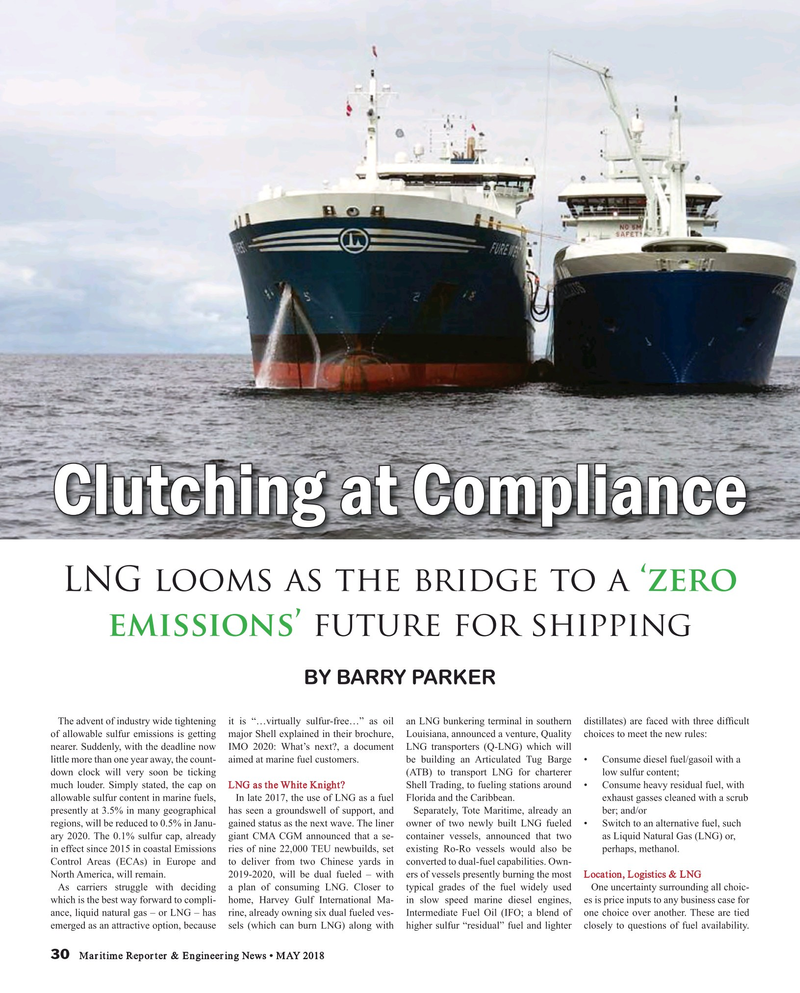
Page 30: of Maritime Reporter Magazine (May 2018)
Marine Propulsion Edition
Read this page in Pdf, Flash or Html5 edition of May 2018 Maritime Reporter Magazine
Clutching at ComplianceClutching at Compliance
LNG looms as the bridge to a ‘zero emissions’ future for shipping
BY BARRY PARKER
The advent of industry wide tightening it is “…virtually sulfur-free…” as oil an LNG bunkering terminal in southern distillates) are faced with three dif? cult of allowable sulfur emissions is getting major Shell explained in their brochure, Louisiana, announced a venture, Quality choices to meet the new rules: nearer. Suddenly, with the deadline now IMO 2020: What’s next?, a document LNG transporters (Q-LNG) which will little more than one year away, the count- aimed at marine fuel customers. be building an Articulated Tug Barge • Consume diesel fuel/gasoil with a down clock will very soon be ticking (ATB) to transport LNG for charterer low sulfur content; much louder. Simply stated, the cap on LNG as the White Knight? Shell Trading, to fueling stations around • Consume heavy residual fuel, with allowable sulfur content in marine fuels, In late 2017, the use of LNG as a fuel Florida and the Caribbean. exhaust gasses cleaned with a scrub presently at 3.5% in many geographical has seen a groundswell of support, and Separately, Tote Maritime, already an ber; and/or regions, will be reduced to 0.5% in Janu- gained status as the next wave. The liner owner of two newly built LNG fueled • Switch to an alternative fuel, such ary 2020. The 0.1% sulfur cap, already giant CMA CGM announced that a se- container vessels, announced that two as Liquid Natural Gas (LNG) or, in effect since 2015 in coastal Emissions ries of nine 22,000 TEU newbuilds, set existing Ro-Ro vessels would also be perhaps, methanol.
Control Areas (ECAs) in Europe and to deliver from two Chinese yards in converted to dual-fuel capabilities. Own-
North America, will remain. 2019-2020, will be dual fueled – with ers of vessels presently burning the most Location, Logistics & LNG
As carriers struggle with deciding a plan of consuming LNG. Closer to typical grades of the fuel widely used One uncertainty surrounding all choic- which is the best way forward to compli- home, Harvey Gulf International Ma- in slow speed marine diesel engines, es is price inputs to any business case for ance, liquid natural gas – or LNG – has rine, already owning six dual fueled ves- Intermediate Fuel Oil (IFO; a blend of one choice over another. These are tied emerged as an attractive option, because sels (which can burn LNG) along with higher sulfur “residual” fuel and lighter closely to questions of fuel availability. 30 Maritime Reporter & Engineering News • MAY 2018
MR #5 (26-33).indd 30 MR #5 (26-33).indd 30 5/4/2018 3:13:42 PM5/4/2018 3:13:42 PM

 29
29

 31
31
